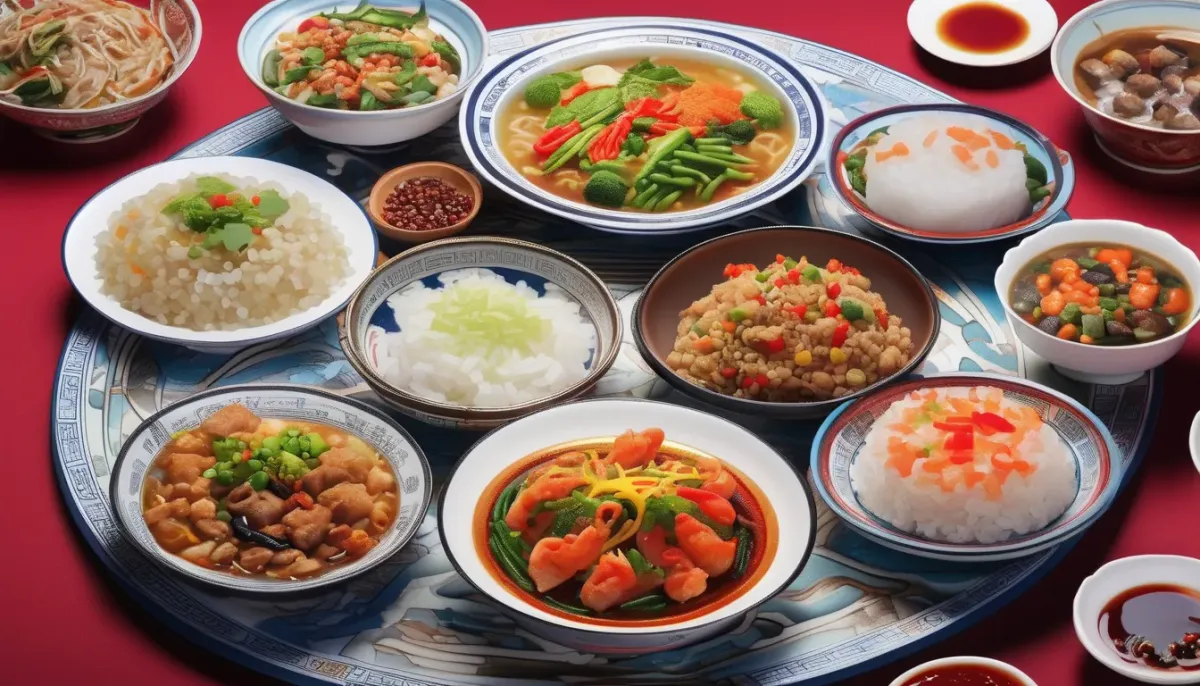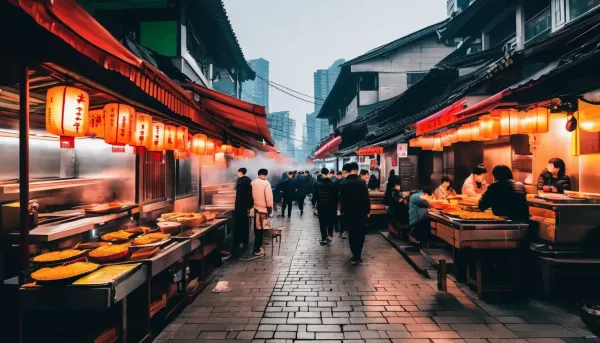Chinese Northeastern Cuisine
Chinese Northeastern cuisine, or "Dongbei Cai," is hearty and perfect for sharing. Known for its generous portions and bold flavors, it combines influences from Russian, Korean, and Mongolian cuisines, offering warmth and comfort in every bite.

Chinese Northeastern cuisine, known as "Dongbei Cai" (东北菜), hails from the three northeastern provinces of China: Heilongjiang, Jilin, and Liaoning. This cuisine is an embodiment of the region's cold climate, agricultural abundance, and multicultural history. With influences from neighboring Russia, Korea, and Mongolia, Northeastern Chinese cuisine stands out for its hearty, robust, and straightforward flavors. This article delves into the characteristics of Northeastern cuisine, exploring its key ingredients, signature dishes, and cultural significance.
A Reflection of the Northeastern Climate
The harsh winters of Northeastern China, where temperatures can plummet to as low as -30°C (-22°F), have played a significant role in shaping the region's cuisine. The long, cold months necessitate foods that are not only filling but also warming. As a result, dishes are often hearty, with generous portions of meat, root vegetables, and fermented ingredients that can be preserved through the winter.
The concept of "warming" foods is central to Northeastern cuisine. These are typically dishes that are rich in calories and fat, providing the necessary energy to endure the cold. For example, stews and braised dishes are common, often cooked with fatty cuts of meat like pork belly or lamb. These dishes are slow-cooked to tenderize the meat, allowing the flavors to meld together into a rich, comforting meal.
The Generous Portions of Northeastern Cuisine
One of the distinctive features of Northeastern cuisine is the large portion sizes of each dish. The people of Northeastern China have a reputation for their hearty appetites, and this is reflected in the way their food is served. A typical meal in this region is designed to be shared among family and friends, with large platters of food placed in the center of the table for everyone to enjoy.
It is not uncommon for a table of seven or eight people to be fully satisfied with just five or six dishes. Each dish is typically substantial enough to feed multiple people, making it an ideal cuisine for communal dining. This practice of sharing food not only fosters a sense of togetherness but also ensures that everyone gets to experience the full range of flavors and textures that Northeastern cuisine has to offer.
Staple Ingredients: Root Vegetables, Pickles, and Grains
Northeastern China’s agriculture thrives on hardy crops that can withstand the region’s short growing season. Potatoes, cabbages, carrots, and turnips are staple vegetables in the Northeastern diet. These root vegetables are versatile, appearing in everything from stews to stir-fries.
One of the most distinctive features of Northeastern cuisine is its extensive use of pickling and fermentation. Given the long winters, pickled vegetables (腌菜, yancai) are a crucial part of the diet. Cabbage, radish, and cucumber are commonly pickled and serve as side dishes or ingredients in other recipes. These pickles not only add a refreshing tang to the otherwise rich and savory dishes but also provide essential vitamins during the winter months.
Grains, particularly wheat and corn, also play a significant role in the Northeastern diet. Unlike Southern China, where rice is the staple, Northeastern cuisine favors wheat-based products like noodles, dumplings, and steamed buns. Corn is often ground into flour to make various types of pancakes and steamed breads, which are usually served alongside meat and vegetable dishes.
Signature Dishes of Northeastern Cuisine
1. Guo Bao Rou (锅包肉):
Guo Bao Rou is one of the most iconic dishes of Northeastern cuisine. It consists of thin slices of pork tenderloin, lightly battered and deep-fried until crispy. The pork is then coated in a sweet and sour sauce made from vinegar, sugar, and sometimes a touch of ginger. The result is a dish that is crispy on the outside, tender on the inside, with a perfect balance of sweet and tangy flavors.
2. Di San Xian (地三鲜):
Di San Xian, which translates to "Three Treasures of the Earth," is a simple yet flavorful vegetarian dish that highlights the essential ingredients of Northeastern cuisine: potatoes, eggplant, and green peppers. These vegetables are stir-fried until they are golden and slightly crispy, then tossed in a savory garlic and soy sauce. The dish is a celebration of the natural flavors of the vegetables, enhanced by the umami of the sauce.
3. Suan Cai Bai Rou (酸菜白肉):
Suan Cai Bai Rou is a quintessential winter dish, combining the region's love for pickles and pork. This hot pot-style dish features thin slices of pork belly cooked with suan cai (酸菜), a type of pickled Chinese cabbage. The pickled cabbage imparts a tangy flavor to the rich, fatty pork, creating a dish that is both comforting and satisfying. It is often served with vermicelli noodles or steamed buns to soak up the flavorful broth.
4. Dongbei Da Lapi (东北大拉皮):
Dongbei Da Lapi is a cold salad made with mung bean noodles (also known as "cellophane noodles" or "glass noodles"). The noodles are tossed with julienned vegetables, such as cucumbers and carrots, and sometimes strips of cooked meat or tofu. The dressing is typically a mixture of soy sauce, vinegar, garlic, and sesame oil, creating a dish that is refreshing and full of contrasting textures.
5. Shao Bing (烧饼) and Su Bing (酥饼):
These are traditional baked goods often found in Northeastern China. Shao Bing is a type of flatbread that can be either savory or sweet, usually filled with sesame paste, red bean paste, or minced meat. Su Bing, on the other hand, is a flaky pastry that is typically filled with sweet fillings like sugar or jujube paste. Both are enjoyed as snacks or breakfast items and are often accompanied by a bowl of congee or soy milk.
The Influence of Neighboring Cultures
Northeastern Chinese cuisine is a melting pot of influences from its neighbors, including Russia, Korea, and Mongolia. The Russian influence is particularly evident in the use of potatoes, bread, and dairy products, which are not as common in other Chinese cuisines. For example, dishes like Russian-style borscht (罗宋汤) and Russian bread (列巴) have been adapted into the local cuisine and are widely enjoyed in the region.
Korean cuisine has also left its mark on Northeastern food, particularly in the form of kimchi and Korean-style barbecue. The large Korean-Chinese population in the region has introduced dishes like kimchi (泡菜), which is often incorporated into Northeastern meals, adding a spicy and tangy kick to the dishes. Korean barbecue restaurants are also popular, where diners can grill their own meat at the table, often accompanied by a variety of pickled vegetables and dipping sauces.
Mongolian influences are evident in the emphasis on lamb and beef, which are more commonly consumed in Northeastern China than in other parts of the country. Dishes like Mongolian-style hot pot (涮羊肉) and grilled lamb skewers (烤羊肉串) are favorites in the region, reflecting the nomadic traditions of the Mongolian people.
The Cultural Significance of Northeastern Cuisine
Northeastern cuisine is more than just food; it is a reflection of the region’s history, culture, and way of life. The hearty and warming dishes are a testament to the resilience of the Northeastern people, who have historically faced harsh living conditions. The emphasis on communal dining, with large portions meant to be shared, reflects the strong sense of community and hospitality in the region.
Family gatherings, especially during festivals like Chinese New Year, often feature a feast of Northeastern dishes. Dumplings (饺子) are a must-have, symbolizing wealth and prosperity. These are often handmade by the entire family, with everyone contributing to the preparation, rolling out dough, filling, and folding the dumplings. The process itself is a bonding experience, highlighting the importance of family in Northeastern culture.
The communal nature of Northeastern cuisine is also evident in the tradition of "Ganbei" (干杯), which means "dry your glass" and is similar to "cheers" in English. Drinking, often of strong spirits like baijiu (白酒), is a significant part of dining in Northeastern China. It is a way to strengthen bonds, celebrate, and show respect. Meals are often accompanied by multiple rounds of toasting, where everyone at the table is expected to participate.
Conclusion: A Cuisine of Heart and Soul
Northeastern Chinese cuisine is a unique and integral part of China’s culinary landscape. It is a cuisine that speaks to the heart and soul, offering warmth and comfort in every bite. The flavors are bold, the portions generous, and the dishes are designed to be shared, embodying the spirit of the region. Whether it's the tangy Suan Cai Bai Rou, the crispy Guo Bao Rou, or the simple yet satisfying Di San Xian, each dish tells a story of tradition, resilience, and the unbreakable bonds of family and community.



